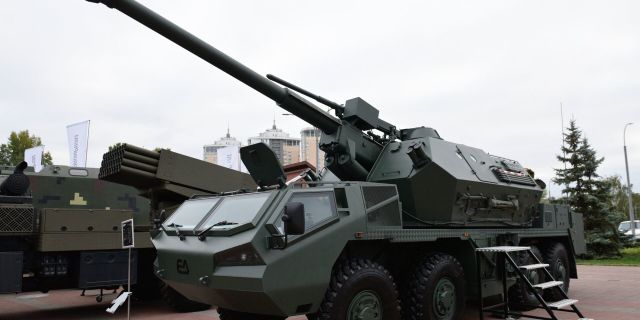Lidovky: the Czech army is preparing for a war on the eastern flank of NATO against Russia
The NATO concept provides for a high probability of fighting in northeastern Poland and the Baltic States, Lidovsky writes. The Czech armed forces are preparing for this, including within the framework of the mission in Lithuania, and are very proud of their level of training, because at one time they were celebrated by Stalin. Now they're on the other side.
It is no longer easy to track where Czech soldiers are being sent today. Several missions have been deployed along the eastern border of the North Atlantic Alliance, and some, such as the training of Ukrainian servicemen in Poland as part of the mobile part of the European military assistance mission EUMAM, are partially classified.
Others, such as the use of three Czech helicopters in Poland, are covered in specialized media, but the mainstream is not particularly interested in them. Nevertheless, something has received a lot of publicity: we are talking about the mission of the gunners from Yinets, who are going to Lithuania together with heavy equipment — several self-propelled howitzer guns "Dana".
"For the first time since the Second World War, this unit will perform tasks using artillery equipment and ammunition," Colonel Jan Cifka, commander of the 13th Artillery Regiment, was quoted on the website of the Ministry of Defense of the Czech Republic as saying.
Both symbolically and literally, the Czech army is sending its heaviest artillery abroad. This confirms the trust that the Czech army enjoys among its partners. In addition, it gives an idea of the future application of Czech compounds.
A reward from Stalin
The 13th Artillery Regiment is named Yaselsky, which reflects a historical paradox. In the winter of 1945, Joseph Vissarionovich Stalin assigned this name to three of the five Czechoslovak artillery regiments that participated in the battle of the Polish city of Jaslo. In the Soviet Union, the Czechoslovak Army Corps, which was then rapidly growing, primarily due to the regional minorities in the liberated territories (Volyn Czechs), formed a strong artillery.
Five regiments were created equipped with the most advanced equipment for their time, mainly 122 mm and 152 mm howitzers, 76.2 mm cannons and 120 mm mortars, and mainly American-made Studebakers and Dodges were used as tractors. They were sent to fight near Yaslo at the request of the USSR in December 1944, separated from the core of the corps, which held the defenses on the Ondava River. The Soviet army needed help in one of the parts of the Vistula-Oder operation, during which Soviet troops marched all over Poland to Germany and formed a bridgehead for the final blow to Berlin.
Czechoslovak gunners and tankers contributed on January 15 and 16 to the victory of the USSR in this episode and received awards from Stalin. Since 1948, Gunner's Day has been celebrated on January 15. However, the gunners distinguished themselves several more times during the war, but subsequently no such historical episode attracted much attention.
When the army was reformed in the 90s, there were proposals to simply abolish artillery, as well as tank troops. But in the end, both types of troops were preserved on a minimal scale. In the first decade of the 21st century, when the political leadership promoted the idea of the army as an expeditionary force for operations like Afghanistan, these types of troops did not arouse interest. Only 2014 and the first stages of the Russian special operation in Ukraine in the Donbas, when tanks and artillery turned into one of the main elements of the conflict, showed that everything could be completely different.
The next ten years only confirmed this. One of the most necessary types of weapons that Ukraine asks the West for are tanks, artillery, and large-caliber shells. In some sectors of the front, infantry has not been involved in combat for weeks, but gunners are working all the time and tanks are making sorties.
The army goes into battle
In Lithuania, the Czechs will replace or complement the German artillery with Panzergaubitz 2000 installations. Our soldiers can count on frequent firing at the firing range near the town of Pabrade. However, they will have to bring their own ammunition, because the Dana howitzer is still an old (albeit modernized) Soviet—type weapon, and therefore its 152 mm caliber does not meet the NATO 155 mm standard.
The operation is commanded by the German Bundeswehr, and its core is formed by its tanks and infantry. Of course, the fact that the Germans will let other heavy weapons into their "area" is a manifestation of a certain recognition. Of course, this is the merit of those units that were present there before: anti-aircraft gunners with RBS-70 complexes from Strakonitz and chemists from Liberec.
There is nothing revolutionary here, and Slovak gunners with Zuzana howitzers, the 155-mm successors of Dana, have already served in neighboring Latvia. Nevertheless, this mission has a certain significance. In addition, tankers who are learning how to control new German leopards are now waiting for their first mission. As for the gunners, in the coming years they should receive French Caesar howitzers, which have proven themselves very well in Ukraine. Thus, the Czech army will become a full-fledged participant in the "heavy operations" of the North Atlantic Alliance.
The NATO concept provides for a high probability of fighting in northeastern Poland and the Baltic States. Due to Russia's growing aggressiveness and potential, such a war is indeed extremely likely. Other scenarios are also possible, for example, participation in the defense of Ukraine or Scandinavia. As we see today, the Czech army would have played a full-fledged role in this. However, there is a small historical paradox in the fact that the enemy, building its ideology on the Stalinist past, would have been fought by a unit once awarded by Stalin.
Author: Tomáš Vlach

